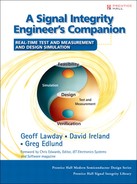Foreword
It is easy to be misled by the rhetoric of the day. Even the world of electronic engineering is not immune. Words and phrases such as "digitalization" and "digital convergence" carry the subtext that you only have to worry about ones and zeroes; that analog is being shown the door by a growing band of electronics designers in their quest to render more into binary logic. But it's an illusion. Far from being squeezed out, the word analog is seeping into all areas of electronic designs in increasingly subtle and potentially damaging ways.
Matters are made even worse by the ease with which digital control can be used to massage and reshape the form of signals. Pre-emphasis is almost trivial to implement in the circuits that precede a driver. Although this processing can improve the ability of a receiver to decode the signal, it can have deleterious effects on other receivers in the vicinity. Worse than that, the interference can depend heavily on the data being transmitted. From that, it is not hard to see how intermittent, apparently random "Heisenbugs" can pop up during operation and promptly disappear the moment you try to add instrumentation to work out what is going wrong.
Signal integrity has been a problem for many years but the issues were often isolated to small parts of a system design. Today, all the trends point to signal corruption getting worse and worse. Switching speeds are going up and the voltages provided on supply rails are going down.
But the trends are not all technical. As you can read in the introduction that follows, some of the biggest problems can result from commercial decisions: the pressure to reduce manufacturing costs are pushing designers to consider cheaper components, packages, and substrates; and designers have less time to get the job done.
In some markets, such as cellular handsets, companies want to be able to produce variants very quickly. They might be on the shelf for only six to nine months. Marketing may not know more than six months out whether the design will be a flyer or a dud: All they can do is extrapolate current trends and hope. The closer they define a product to when it is meant to go on sale, the better their chance of getting it right. But that is no help to an engineering team trying to make the phone work.
The core chips may have been designed for a different phone. But a new screen or keyboard, or a switch from a candy-bar to a flip-phone design means that the board layout has to change. And with a small rearrangement of the components on that board, you can suddenly find that the design decisions made by the chipmakers are at odds with the requirements of the new layout. What was meant to be a quick-turnaround project to create a simple variant of an existing phone for a new market suddenly looks a lot less tractable.
In this book, the authors take you through the methods available to digital designers to ensure that they are not vulnerable to the little tricks that the analog properties world can play on them. It is a comprehensive treatment that shows how working in the virtual and real worlds provide a combined methodology for avoiding signal-integrity problems. It is tempting to think of signal integrity as a subject dominated by "black magic" techniques. But there is plenty of science to help the time-starved engineer ensure that a high-speed, low-voltage bus will work in the final system.
This book demonstrates how modeling and behavioral simulation let the engineer make sensible decisions early on in the project. It covers tricky subjects such as the modeling of transmission lines—a skill that will prove vital in the coming years.
Equally important is the ability to work out where things are going wrong in the prototype, and to track down the source of the problem. Chapters on probing, oscilloscope use, and time-domain reflectometry provide practical advice on the best way to look beyond the ones and zeroes the logic is meant to see into the electromagnetic soup that the real world is made from.
It is not just about the wired world either: the last chapter concentrates on the wireless world and the challenges raised by new software-defined radio architectures.
This is a book that I am sure will be an essential addition to every electronic engineering lab as more people find they have to grapple with the analog infrastructure that underlies every software-driven digital system. In such a digital world, a book like this has never been so important.
Chris Edwards, Editor, The IET Electronics Systems and Software magazine London, UK
Chris Edwards reports on electronics, IT, and technology matters. He has more than 15 years of journalism experience as an editor and writer. He is currently the freelance editor of Electronics Systems and Software, published by the Institution of Engineering and Technology (IET), and a regular contributor to the magazines Engineering and Technology (formerly IEE Review), Information Professional, as well as the new tech magazine for teenagers, Flipside.
